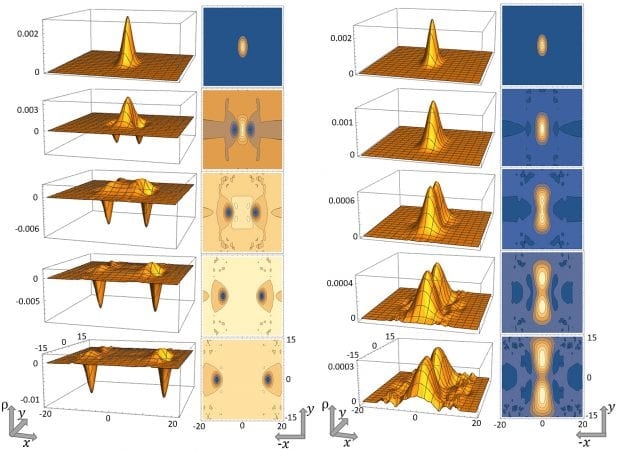Mar 5 2019
Matthew Foster and Seth Davis ’15, physicists at Rice University, intend to take a completely fresh look of an exasperating quantum puzzle. All they need is a suitable vantage point and a place that is colder than deep space.
 In an ultracold atomic experiment proposed by Rice University physicists Matthew Foster and Seth Davis ’15, quantum fractionalization would be observed by density waves propagating in the direction of 1D quantum waveguides (left). In the absence of fractionalization (right), density waves would spread in a perpendicular direction. (Image credit: Matthew Foster/Rice University)
In an ultracold atomic experiment proposed by Rice University physicists Matthew Foster and Seth Davis ’15, quantum fractionalization would be observed by density waves propagating in the direction of 1D quantum waveguides (left). In the absence of fractionalization (right), density waves would spread in a perpendicular direction. (Image credit: Matthew Foster/Rice University)
“There’s a process in strongly interacting physics where fundamental particles, like electrons, can come together and behave as if they were a fraction of an electron,” stated Davis, a graduate student in Foster’s research group. “It’s called fractionalization. It’s a really exotic, fundamental process that shows up theoretically in many places. It may have something to do with high-temperature superconductivity, and it could be useful for building quantum computers. But it’s very hard to understand and even harder to measure.”
In a paper recently published in Physical Review Letters, theoretical physicists Foster and Davis put forward an experiment to evaluate fractionalization not in electrons but in atoms that are very cold that they obey the same quantum rules that govern the behavior of electrons in quantum materials, an expanding category of materials with exotic physical and electronic properties that industry and governments are looking toward for futuristic electronic devices and computers.
High-temperature superconductors, which are one of the mysterious materials in physics, and materials exhibiting topological phases (the discovery for which the 2016 Nobel Prize in Physics was awarded) are some examples of quantum materials. The latter is the only instance in which physicists have explicitly measured fractionalization, in an exotic electronic state known as the fractional quantum Hall effect. In this state, electricity is conducted by flat two-dimensional (2D) materials only along their one-dimensional (1D) edges.
That’s a 2D example. And it’s clear that fractionalization is occurring there because if you measure the conductance of these edge states they behave as though they’re made of particles that behave like one-third of an electron. There are no real particles carrying one-third of the electric charge. It’s just the effect of all the electrons moving together in a such a way that if you create a local excitation, it will behave like an electron with one-third of a charge.
Matthew Foster, Assistant Professor of Physics and Astronomy, Rice University
According to Foster and Davis, the important motivating factor in characterizing their ultracold atomic test was to be in a position to observe fractionalization in a system that is quite distinct from the fractional quantum Hall example.
“What we’re aiming at is just seeing this physics in one other context in an unambiguous way,” stated Foster, a member of Rice’s Center for Quantum Materials (RCQM).
In the proposed experiment, laser-cooling atoms are assumed to act as substitutes for electrons. In experiments such as this, the atomic motion is opposed by the lasers, gradually slowing them to much colder temperatures. Other lasers trap the cold atoms and form optical waveguides, which are 1D channels in which atoms are free to move left or right but cannot move around each other. The atoms’ quantum behavior in such 1D guides emulates the electrons’ behavior in 1D wires.
“All of the individual elements of the experiment have been developed, but we don’t believe they’ve been put together in a single experimental setup,” stated Foster. “That’s where we need the help of experimentalists who are experts in laser-cooling.”
In order to observe fractionalization in an ultracold system, Foster and Davis suggest developing a set of parallel 1D waveguides, all located in the same 2D plane. Close to the center of the experiment, the 1D guides would be populated by a few additional atoms.
So we’ll start with the 1D ‘wires,’ or guides, and the initial density in the middle, and then we’ll drop some of the lasers and allow the atoms to interact between the wires in a kind of 2D mesh. We can very accurately describe the 1D system, where strong interactions cause the atoms to behave in a correlated way. Because the whole system is quantum mechanical and coherent, those correlations should get imprinted on the 2D system. Our probe is letting go of that extra bump of density and watching what it does. If the atoms in the 1D guides are not interacting, then the bump will just spread out between the wires. But, if there was initial fractionalization due to correlated effects in the wires, what we can confidently calculate is that the density will do something completely different. It will go the other direction, flying down the wires.
Matthew Foster, Assistant Professor of Physics and Astronomy, Rice University
Foster stated that he takes interest in debating with ultracold atomic experimentalists about the feasibility of the test.
We know it can take years to build and perfect some of the experimental setups for these kinds of experiments. As theorists, we know the ingredients we need, but we don’t know the ones that will be most challenging to implement or if it may be easier to modify some setups as opposed to others. That’s where we’ll need the help of our experimental colleagues.
Matthew Foster, Assistant Professor of Physics and Astronomy, Rice University
The National Science Foundation, the Army Research Office, and the Welch Foundation supported the study. The physicists used the National Science Foundation-supported DAVinCI supercomputer administered by Rice’s Center for Research Computing and procured in collaboration with Rice’s Ken Kennedy Institute for Information Technology.